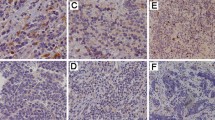Abstract
Neuroblastoma (NB) accounts for 15% of all childhood cancer deaths. The majority of patients have widespread lymphatic and/or haematogenous metastases at diagnosis, but lymphangiogenesis has not been well documented. Sixty-seven NBs were immunostained for the lymphatic endothelial marker, LYVE-1, and the lymphatic density (LD) and lymphatic invasion (LI), were counted in LYVE-1-expressing lymphatics. LYVE-1-stained lymphatic vessels and LI were present in 26/67 (39%) and 14/67 (21%) of the NBs, respectively. Central LD (CLD) and LI were higher in NBs from stage 4 (p = 0.012, p = 0.004, respectively), high-risk group (p = 0.030, p = 0.002), NBs with high mitosis karyorrhexis index (MKI) (p = 0.011, p = 0.005), unfavourable histology group (p = 0.040, p = 0.017) and distant lymph node metastasis (LNM) (p < 0.001 for each). Marginal LD (MLD) was higher in patients with LNM (p < 0.001). CLD and MLD correlated with LI (p < 0.001 each). Total LYVE-1 protein levels, quantified by a sensitive enzyme-linked immunosorbent assay (n = 55), were also higher in NBs from patients with stage 4 disease (p = 0.046), high-risk group (p = 0.028), MYCN-amplified NBs (p = 0.034) and LNM (p = 0.038). Kaplan–Meier analysis showed that the presence of CLD was associated with both worse OS at 5 years (77% [95% CI: 62–87%] versus 60% [95% CI: 32–80%], p = 0.062) and EFS (74% [95% CI: 58–85%] versus 43% [95% CI: 15–69%], p = 0.070) and LI with OS (71% [95% CI: 57–81%] versus 56% [95% CI: 26–78%], p = 0.055). Significant upregulation of LYVE-1 and the presence of LI in patients with stage 4 and high-risk disease, MYCN-amplification and LNM suggests that LYVE-1 may have value as predictors of outcome.



Similar content being viewed by others
Abbreviations
- NB:
-
Neuroblastoma
- LYVE-1:
-
Lymphatic vessel endothelial hyaluronan receptor-1
- LD:
-
Lymphatic density
- CLD:
-
Central lymphatic density
- MLD:
-
Marginal lymphatic density
- LNM:
-
Lymph node metastasis
- LI:
-
Lymphatic invasion
References
Maris JM, Hogarty MD, Bagatell R et al (2007) Neuroblastoma. Lancet 369:2106–2120
Cohn SL, Pearson AD, London WB et al (2009) The International Neuroblastoma Risk Group (INRG) classification system: an INRG Task Force report. J Clin Oncol 27:289–297
Shimada H, Ambros IM, Dehner LP et al (1999) The International Neuroblastoma Pathology Classification (the Shimada system). Cancer 86:364–372
Rossler J, Taylor M, Geoerger B et al (2008) Angiogenesis as a target in neuroblastoma. Eur J Cancer 44:1645–1656
Lagodny J, Juttner E, Kayser G et al (2007) Lymphangiogenesis and its regulation in human neuroblastoma. Biochem Biophys Res Commun 352:571–577
Ribatti D, Nico B, Cimpean AM et al (2010) Podoplanin and LYVE-1 expression in lymphatic vessels of human neuroblastoma. J Neurooncol 100:151–152
Becker J, Wang B, Pavlakovic H et al (2010) Homeobox transcription factor Prox1 in sympathetic ganglia of vertebrate embryos: correlation with human stage 4 s neuroblastoma. Pediatr Res 68:112–117
Becker J, Pavlakovic H, Ludewig F et al (2010) Neuroblastoma progression correlates with downregulation of the lymphangiogenesis inhibitor sVEGFR-2. Clin Cancer Res 16:1431–1441
Eggert A, Ikegaki N, Kwiatkowski J et al (2000) High-level expression of angiogenic factors is associated with advanced tumor stage in human neuroblastomas. Clin Cancer Res 6:1900–1908
Komuro H, Kaneko S, Kaneko M et al (2001) Expression of angiogenic factors and tumor progression in human neuroblastoma. J Cancer Res Clin Oncol 127:739–743
Nowicki M, Konwerska A, Ostalska-Nowicka D et al (2008) Vascular endothelial growth factor (VEGF)-C—a potent risk factor in children diagnosed with stadium 4 neuroblastoma. Folia Histochem Cytobiol 46:493–499
Sleeman JP, Thiele W (2009) Tumor metastasis and the lymphatic vasculature. Int J Cancer 125:2747–2756
Baluk P, McDonald DM (2008) Markers for microscopic imaging of lymphangiogenesis and angiogenesis. Ann N Y Acad Sci 1131:1–12
Van der Auwera I, Cao Y, Tille JC et al (2006) First international consensus on the methodology of lymphangiogenesis quantification in solid human tumours. Br J Cancer 95:1611–1625
Beasley NJ, Prevo R, Banerji S et al (2002) Intratumoral lymphangiogenesis and lymph node metastasis in head and neck cancer. Cancer Res 62:1315–1320
Van der Auwera I, Van den Eynden GG, Colpaert CG et al (2005) Tumor lymphangiogenesis in inflammatory breast carcinoma: a histomorphometric study. Clin Cancer Res 11:7637–7642
Maris JM (2010) Recent advances in neuroblastoma. N Engl J Med 362:2202–2211
Gombos Z, Xu X, Chu CS et al (2005) Peritumoral lymphatic vessel density and vascular endothelial growth factor C expression in early-stage squamous cell carcinoma of the uterine cervix. Clin Cancer Res 11:8364–8371
Straume O, Jackson DG, Akslen LA (2003) Independent prognostic impact of lymphatic vessel density and presence of low-grade lymphangiogenesis in cutaneous melanoma. Clin Cancer Res 9:250–256
Dadras SS, Paul T, Bertoncini J et al (2003) Tumor lymphangiogenesis: a novel prognostic indicator for cutaneous melanoma metastasis and survival. Am J Pathol 162:1951–1960
Acknowledgments
The authors would like to thank Above and Beyond Charities of the University Hospitals Bristol Foundation Trust for their financial support and Ince & Co for their private donation. The authors are grateful to Mr. P.B. Savage for providing laboratory facilities.
Conflict of interest
The authors declare that there is no conflict of interest. No part of the article has been published or submitted elsewhere, and there are no financial relationships that may lead to conflict of interest. The manuscript has been read and approved by all authors.
Author information
Authors and Affiliations
Corresponding author
Electronic supplementary material
Below is the link to the electronic supplementary material.
Supplementary File 1
Relationship between total protein and variables (DOC 43 kb)
Rights and permissions
About this article
Cite this article
Ramani, P., Dungwa, J.V. & May, M.T. LYVE-1 upregulation and lymphatic invasion correlate with adverse prognostic factors and lymph node metastasis in neuroblastoma. Virchows Arch 460, 183–191 (2012). https://doi.org/10.1007/s00428-011-1190-y
Received:
Revised:
Accepted:
Published:
Issue Date:
DOI: https://doi.org/10.1007/s00428-011-1190-y




